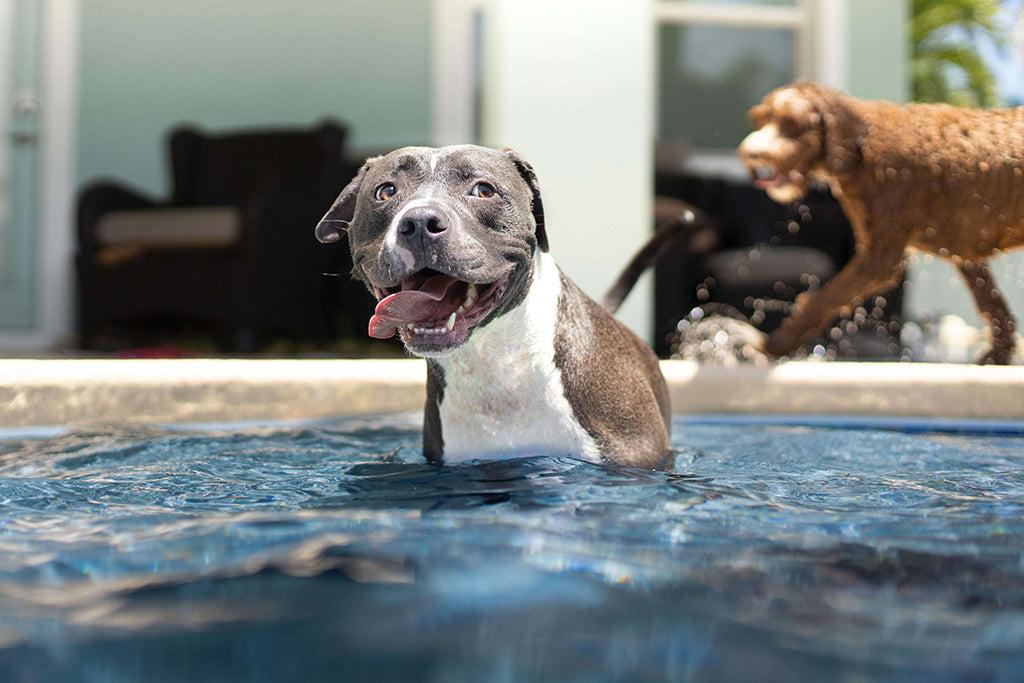Swimming is an absolutely brilliant form of exercise for dogs, and the same goes for humans. As well as providing a thorough aerobic workout, it also strengthens the muscles whilst removing excess pressure from the joints!
Can All Dogs Swim?
Unfortunately, it’s a myth that swimming comes naturally to all dogs. Some dogs seem like they were born to swim, but others seem to tremble at the sight of water. If a dog is short-legged and long-bodied (like the Dachshund), swimming can be quite difficult for them, and for breeds like the Bulldog where their weight is so unevenly distributed, floating and swimming can be a challenge without support from a swimming vest or jacket.
If you own a Labrador Retriever, Nova Scotia Duck Tolling Retriever, Newfoundland, Irish Water Spaniel, German Shorthaired Pointer, or Portuguese Water Dog though, these breeds usually love nothing more than to belly flop into most bodies of water! That’s because these breeds have a suitable physicality and thus make good swimmers.
So no, not all dogs can swim.
Swimming For Dogs – What Are The Benefits?
Swimming for dogs has a host of benefits! But, what are they?
It’s Joint Friendly
Swimming is a non-weight bearing which means there’s little to no impact on their joints and tendons making it perfect for older dogs and those with joint conditions. It also improves their range of motion as swimming makes their joints work in a different way than when moving on solid ground.
Warm Water Swimming Can Be Pain Relieving
When in warm water, a dog’s blood flow can be improved and helps keep their muscles warm too, which reduces the likelihood of further aggravation – great news for pets with a joint condition or recovering from an injury!
It’s Stress Relieving
Swimming comes with a host of mental health benefits for dogs too. It helps burn pent-up energy, is fun and mentally stimulating for them as it’s different from walking and a good, exciting exercise like swimming can help them sleep better and sleep is when the body repairs and rejuvenates itself!

It Can Help Overweight Dogs Lose Weight
If a dog is overweight, walking and running can be incredibly detrimental to their muscles and bones. Swimming can help them burn fat, drop pounds and improve their metabolism without hurting their skeletal and muscular make up.
It Improves Their Health Overall
Did you know that it’s thought one minute of swimming is like doing four minutes of running? Swimming helps strengthen the lungs and the heart helps improve blood circulation (which can help boost their skin and coat health!), can promote the body’s metabolic rate, and can reduce inflammation whilst building muscle tone. Swimming can equal one happy, healthy pooch!
Dog That Can’t Swim? How To Teach A Dog To Swim
No matter how confident your dog is around water, before embarking on attempting a swim, a dog swim vest is always a good idea in case they get into trouble – particularly if the body of water their diving into has a current (a river or the sea). Also, if your dog is under-confident, a life vest will just ensure they float until they’re accustomed and confident enough to try moving their legs.
PetLab Co. Pro Tip: Make sure your dog swim vest has a handle so you can lift your dog out of water in an emergency and get one that has a reflective trim if you’re going out in the evenings or early mornings.
Never just throw a dog into the water despite what some people may advise. This can be terrifying for them, is cruel, and can put them off the activity for life.
Dog Swimming Lessons
First things first, you need to entice your swim-vest attired dog into the water. Whether this is via a treat or a toy, create an atmosphere that seems exciting, fun, and safe. Remember to use an encouraging, calm tone and use lots of praise.
PetLab Co. Pro Tip: Be mindful that if your dog panics and they’re a very large breed they may attempt to climb on you, which can be dangerous. Stay shallow at first!
A great way of encouraging your dog into water is by finding a doggy pal who loves to swim already. This way they can watch and gain confidence from their fellow canine friend and see for themselves that swimming can be fun!

Try to choose a body of water that has a slope, so you can slowly work your way in and out of the water together. If you’re not going into the water yourself, make sure you stay where they exit from the water is so your dog can always be sure where to get out, at least on the first few goes.
When your dog enters the water, praise them lots and when they start to display more confidence in it, praise them again! Positively reinforcing their choice to swim will help them want to swim more and more!
Whilst your dog is learning to swim, keep swimming lessons to 10 minutes at a time. Also, provide them with a snack after swimming which will help absorb any excess water in the stomach that they may have accidentally swallowed. A freeze-dried snack is best for this.
PetLab Co. Pro Tip: Before allowing a dog to swim, always be sure the air temperature and water temperate when added together makes a minimum of 100°F. If the air and water combined are too cold, this can result in conditions like hypothermia which can be fatal for dogs. If your dog jumps into too cold water, begins to shiver, and/or seems to not be able to use their tail, get them to a vet immediately.
If you and your dog go swimming near where people fish, be mindful of loose hooks and bait. If your dog eats any bait, they need to be checked over by a vet pronto.
The same for if they jump in a body of water that’s infected with blue-green algae. Many variations of blue-green algae can be incredibly toxic to dogs. It can stop their liver from functioning and often results in the loss of a dog’s life. Some types of bacteria can kill a pup within an hour, and some as fast as 15 minutes. Blue-green algae is usually found in lakes, ponds and streams and more often during hotter, summer months. It can also be located in bird baths and plant pots. Read more in our blog on the dangers of blue-green algae and what to do here.
If your dog doesn’t like being wet or seems completely scared and reluctant to go in, don’t force them in and make peace with the fact that swimming maybe isn’t the sport for your pup.
Can Dogs Swim In Chlorine Pools?
Yes, a dog can swim in chlorine, but it’s a good idea to give them a rinse with fresh water after a chlorine-water dip to get it out of their coat. However, if your dog wants to drink chlorine water this can pose a problem. Make sure they know their freshwater bowl is nearby to the pool, so they know where to take a drink if they need one.
Make sure to dry your pup after they’ve been swimming, and really focus on drying behind their ears and in the folds of their skin as these areas, when damp and moist, can invite infections to develop if not dried properly.
Sources
“The Top 5 Benefits Of Swimming For Dogs” Top Dog Health https://topdoghealth.com/the-top-5-benefits-of-swimming-for-dogs/
Author Gibeault, Stephanie MSc CPDT “Can All Dogs Swim? How To Teach A Dog To Swim” American Kennel Club, Jun 03. 2021 https://www.akc.org/expert-advice/health/teach-dog-to-swim/






